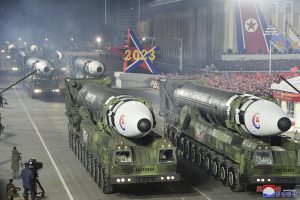North Korea held a military parade at Kim Il Sung Square in Pyongyang, the capital, on Wednesday, according to the North’s state media Korean Central News Agency (KCNA). Based on satellite imagery capturing Pyongyang having rehearsals, outside experts and intelligence officials had predicted that North Korea would hold a military parade to celebrate the 75th anniversary of the founding of the Korean People’s Army (KPA) on February 8. Sure enough, the parade ran from 8:30 p.m. to 10:30 p.m. KST that day.
Wearing a black coat and a black fedora, North Korean leader Kim Jong Un attended the military parade with his wife Ri Sol Ju and his “beloved” daughter, who also appeared during his visit to the lodging quarters of KPA officers on Tuesday. She is the same daughter who made her public debut at an intercontinental ballistic missile (ICBM) launch site in November, rendering speculations as to whether she has been tapped as a successor of her father.
Kim did not deliver a speech during the military parade. However, he clearly showed his “nuke for nuke” principle through the event.
“The columns of ICBMs appeared in the square resounded with the enthusiastic cheers of people full of pride and self-confidence, demonstrating the signal development of the military capability and tremendous nuclear strike capability of the DPRK,” KCNA said. (DPRK is an acronym of the North’s official name: Democratic People’s Republic of Korea.)
Based on the images released by KCNA, at least 11 Hwasong-17 ICBMs were paraded in the event. North Korea also unveiled a new canisterized ICBM and other ICBMs with transport erector launchers (TELs).
Apparently, the key part of the military parade was the showcase of dozens of North Korea’s newest ICBMs. That was a clear message to Washington that Pyongyang’s ICBM capabilities have developed further amid the stalled nuclear talks. Outside experts say that the U.S. ballistic missile defense system would not be able to successfully intercept the North’s ICBMs in the air if they carry multiple warheads. Their analyses may fuel South Koreans’ concerns that the United States might not use all possible resources to defend the South when the U.S. mainland can be targeted by North Korean nuclear missiles. However, it is unclear whether North Korean ICBMs can actually evade the United States’ ballistic missile defenses, as Washington is also trying to expand its defense systems to correspond with the North’s missile developments.
Kim has sent an explicit message to Washington that its demands for the complete, verifiable, irreversible denuclearization (CVID) of North Korea will not happen on his watch, indicating the U.S. policy on North Korea will fail to deter his country’s nuclear and missile development. His messaging implies that the ball is now in Washington’s court, as North Korea’s ICBM capabilities will be advanced going forward. The inclusion of his daughter, who could be Kim’s heir, at military events signals that the fourth generation of the Kim regime will also likely be dedicated to nuclear weapons as the ultimate security guarantee.
Besides showing off its ICBM capabilities, North Korea’s “tactical nuclear weapons operation units” also appeared for the first time in the military parade. As a follow-up step on its moves to lower the threshold for the preemptive use of nuclear weapons, North Korea may deploy tactical nuclear weapons on the front line – which means tactical nuclear weapons operation units could be mobilized near the inter-Korean borders in efforts to maximize leverage against South Korea.
The North’s KN-23 short-range ballistic missiles (SRBMs), which were test-fired multiple times last year, also appeared in the military parade with other missile programs such as self-propelled guns, multiple rocket launchers, and tanks.
Wednesday’s military parade seems to be a depiction of Kim’s bold ambition to make his country strong enough to confront the United States. Kim could have conveyed his messages to the U.S. and South Korea directly through a speech during the military parade. However, Kim seems to have wanted to heighten the dramatic effect by skipping his speech so that the U.S. and South Korean authorities and experts can entirely focus on the missile technologies showcased in the military parade.
Considering the North’s clear intention not to pull back from the power game, South Korea and the United States will need to overhaul their policies on North Korea to resolve the years-long security conflicts in the region.

































